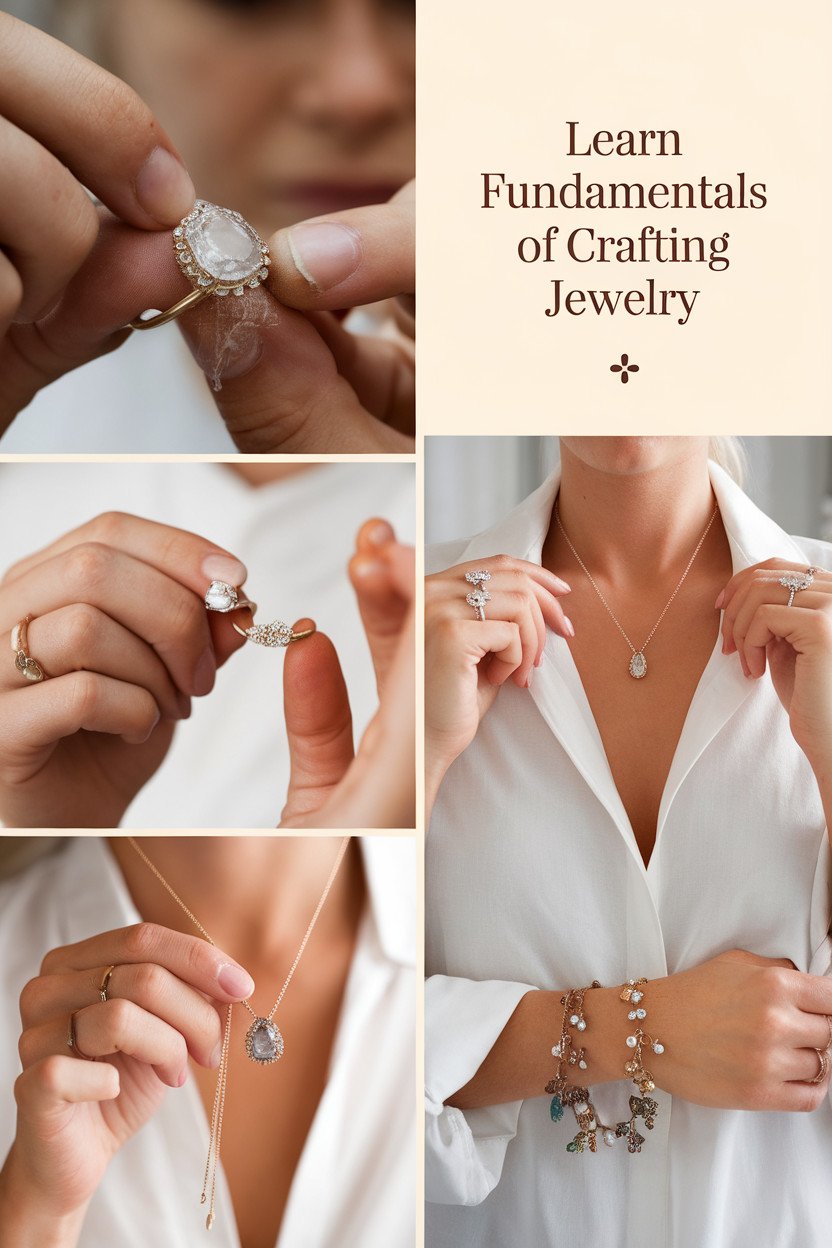Dive into the world of Beading Jewelry Basics and uncover your crafting potential. Whether you’re new to beading or a seasoned pro, this article will provide you with the foundational techniques and tools needed to create your own dazzling pieces.
From choosing the right materials to understanding basic beading techniques, we’ll guide you through every step of the process. With our help, you’ll be able to unleash your creativity and transform beads into Beaded Beauty.
Key Takeaways:
- Learn the foundational techniques and tools needed to create your own beaded jewelry.
- Discover how to choose the right materials and understand basic beading techniques.
- Unleash your creativity and create one-of-a-kind pieces with our guidance and tips.
- Transform beads into wearable works of art.
- Explore the fulfilling and rewarding world of beaded jewelry crafting.
Getting Started: Beading for Beginners
Congratulations on taking the first step towards becoming a beading enthusiast! Whether you’re looking to create custom jewelry pieces or just enjoy the satisfaction of creating something with your own hands, beading is a wonderful hobby that you can enjoy for years to come. Here are some essential steps to get started:
- Choose your materials: Decide on the type of jewelry you want to create and choose the appropriate materials, such as beads, wire, clasps, and findings.
- Get the right tools: Invest in quality tools that will help you complete your projects with ease, such as pliers, wire cutters, and bead mats.
- Learn basic techniques: Start with simple techniques such as stringing and knotting, and work your way up to more complex techniques like wirework and bead-weaving.
- Find inspiration: Look for inspiration in fashion, nature, and other sources to create unique and personalized jewelry pieces.
Remember, beading is a skill that takes time and practice to master, so don’t be discouraged if your first few attempts don’t turn out perfectly. With patience and perseverance, you’ll soon be creating beautiful beaded jewelry that you can be proud of.
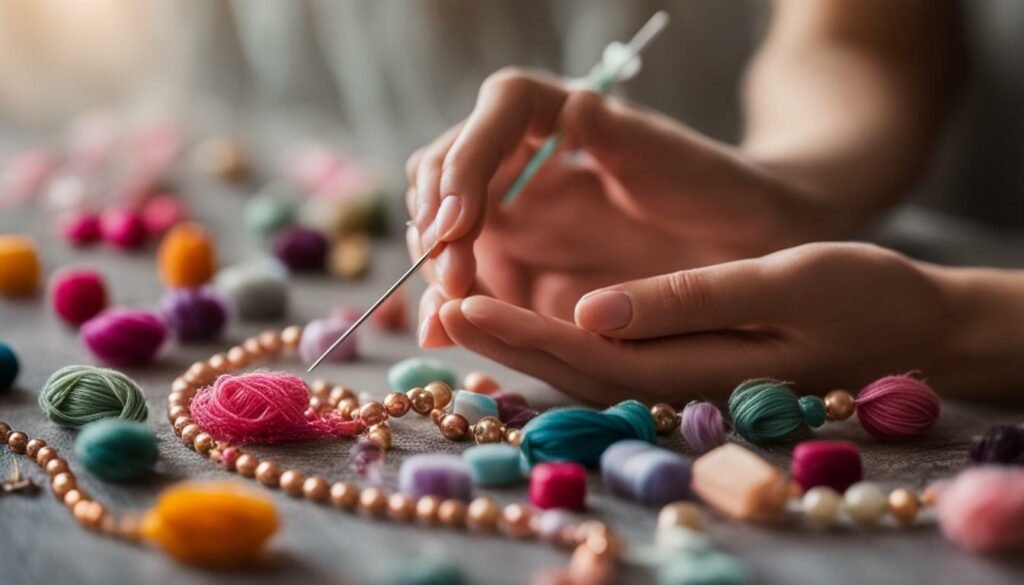
Before you embark on your beading journey, it’s essential to have the right tools and supplies. Here are some must-have items to include in your beading kit:
- Tweezers: For picking up and maneuvering small beads and findings.
- Needle-nose pliers: For bending and twisting wire and opening and closing jump rings.
- Beading needles: Choose a size that fits your thread and beads.
- Beading mat: Protects your work surface from scratches and keeps beads from rolling around.
- Thread: Choose a strong and flexible thread like nylon or beading wire.
- Beads: Start with a variety of shapes, sizes, and colors to experiment with.
- Scissors: For cutting thread and trimming excess wire.
- Crimp beads: Used to secure the ends of your thread or wire.
Building a well-equipped beading kit may seem overwhelming, but starting with these basics will give you a strong foundation to create stunning beaded jewelry.

When it comes to beading techniques, the possibilities are endless. Here are some of the most foundational techniques that every beginner should master:
- Stringing: Stringing beads together is one of the easiest techniques to get started with. Simply add beads to your stringing material, whether that be wire or thread, and create a pattern.
- Knotting: Knotting is used to separate beads and give them space in a necklace or bracelet. This technique is commonly used in between beads to create a pattern and prevent the beads from rubbing against each other.
- Weaving: Weaving is a technique that involves creating patterns with beads by weaving them together with thread. This technique is often used in creating intricate beadwork patterns and designs.
- Wirework: This is a technique that involves using wire to create jewelry instead of traditional stringing material. This technique is great for creating more structural designs and adding a unique touch to your jewelry pieces.
By mastering these foundational techniques, you’ll have a solid base for creating beautiful and unique jewelry designs.
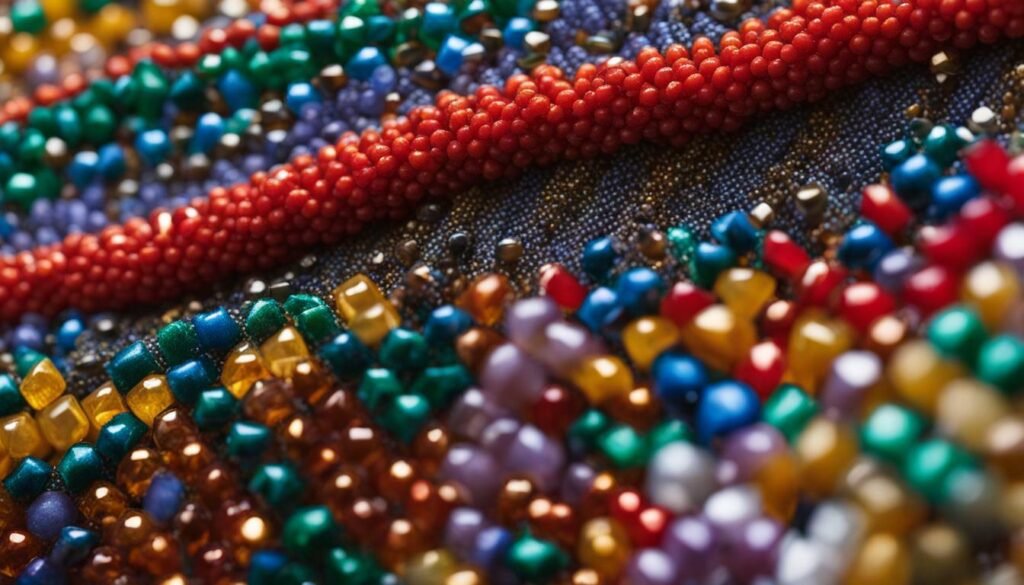
It’s also important to note that beading techniques can be combined to create even more intricate designs. For example, you can use knotting and stringing together to create a pattern, or even use wirework to create a frame for your beadwork.
Additional Beading Techniques
If you’re looking to expand your beading techniques, here are some additional ones to explore:
- Peyote Stitch: This technique involves creating a pattern by weaving beads back and forth in a zig-zag pattern. It’s often used in creating beaded cuffs or bracelets.
- Herringbone Stitch: This stitch creates a textured pattern that resembles a herringbone pattern. It’s often used in creating intricate designs for necklaces and bracelets.
- Brick Stitch: This stitch involves adding beads one at a time in a brick pattern. This technique is often used in creating geometric designs and patterns.
By incorporating a variety of beading techniques into your designs, you’ll be able to create unique and intricate jewelry pieces that truly reflect your own personal style.
Design Inspiration: Finding Your Style
Unleash your creativity with beaded jewelry by finding your unique style. Here are some DIY beaded jewelry design inspirations to get you started:
- Create a nature-inspired necklace by stringing together beads in shades of green and brown to mimic a forest scene.
- Make a statement piece by incorporating geometric shapes into your design, such as hexagons or triangles.
- Use bold colors and patterns to create a bohemian-style bracelet or anklet.
- Add charms, tassels, or other embellishments to personalize your jewelry.
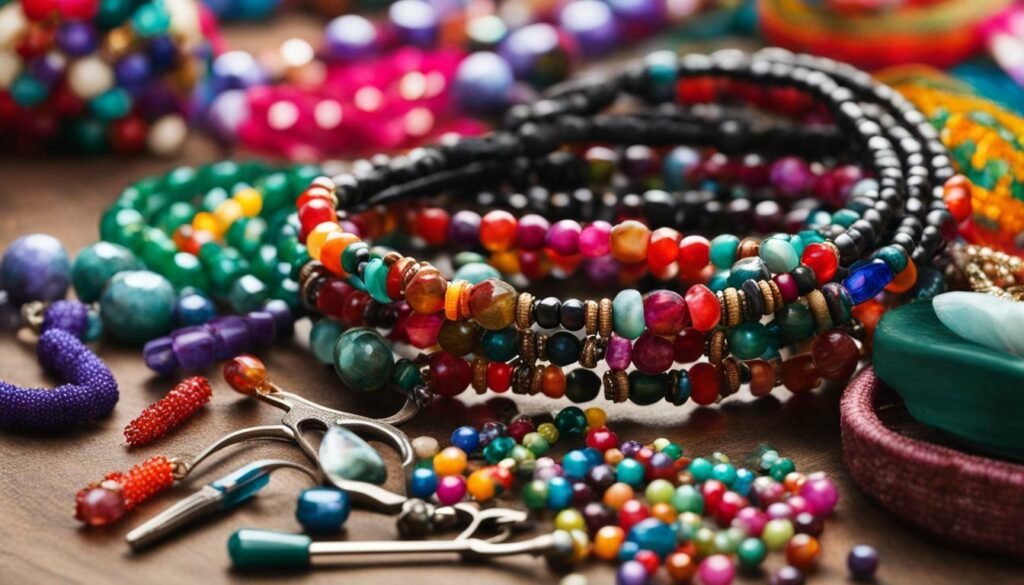
Color plays a crucial role in creating eye-catching and stunning jewelry designs. It can evoke emotions, set a mood, and even communicate a message. Here are some tips to help you choose the perfect color palette for your beaded jewelry:
- Consider the occasion or purpose of the jewelry piece and choose colors that align with the theme.
- Look for inspiration in nature, fashion, and even art.
- Choose colors that complement each other on the color wheel, such as complementary or analogous colors.
- Try incorporating metallic shades, like silver or gold, to add a touch of elegance and sophistication.
- Experiment with different shades and tones of the same color to create depth and texture.
By following these tips, you’ll create beaded jewelry that not only looks beautiful but also communicates your desired message or theme. Don’t be afraid to play around with different color combinations until you find the perfect one.
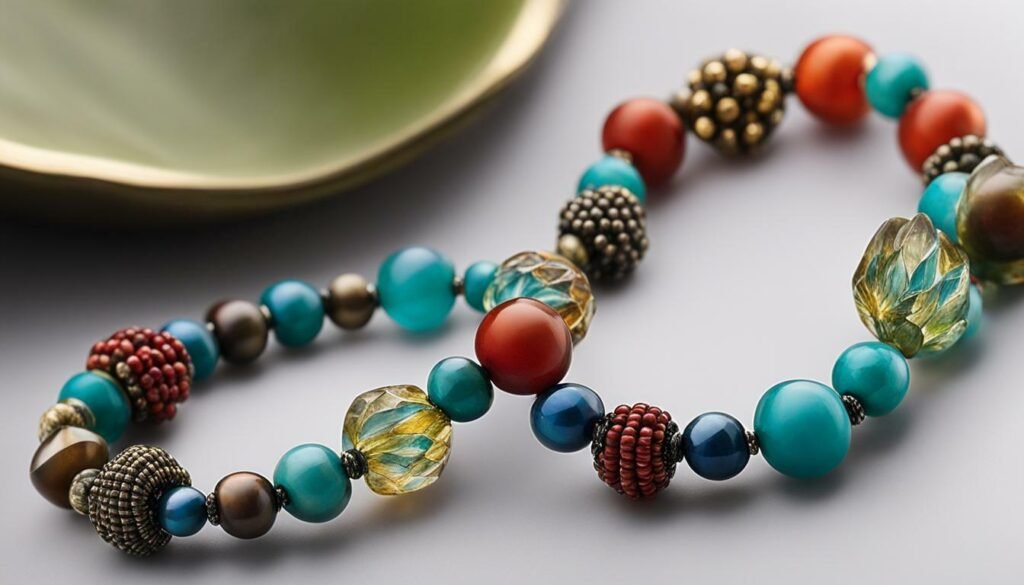
Ready to put your beading skills to the test? Follow along with our detailed step-by-step tutorials to master popular beading stitches and create stunning beadwork.
- Peyote stitch: This versatile stitch is perfect for creating flat, even beadwork and can be used to create patterns and designs.
- Herringbone stitch: Also known as the Ndebele stitch, this stitch creates a flexible and textured beadwork that’s ideal for creating bracelets and necklaces.
- Brick stitch: This stitch creates a brick-like pattern and is perfect for creating beaded earrings and pendants.

With our easy-to-follow tutorials and clear instructions, you’ll be creating beautiful beadwork in no time. Stay tuned for more beading tutorials to take your skills to the next level!
Incorporating Gemstones: Adding a Touch of Elegance
Add a touch of elegance to your beaded jewelry by incorporating gemstones into your designs. Whether you choose to use precious or semi-precious stones, these natural beauties will add a pop of color and depth to your creations. Follow these tips for successful gemstone beading projects:
- Choose high-quality stones: Look for stones that are free of cracks, chips, or scratches. You’ll want to select stones of similar size and shape for consistency in your design.
- Prepare your stones: Clean your stones with a soft cloth before using them in your design. You can also use a bead reamer to enlarge the holes of your stones if needed.
- Integrate your stones: Decide where you want to place your stones in your design and plan accordingly. You can incorporate them by stringing them with your other beads or using them as focal points in wirework jewelry.
- Finishing touches: Make sure to properly secure your gemstones in your design. You can use crimps or knots to hold them in place, depending on the design of your piece.
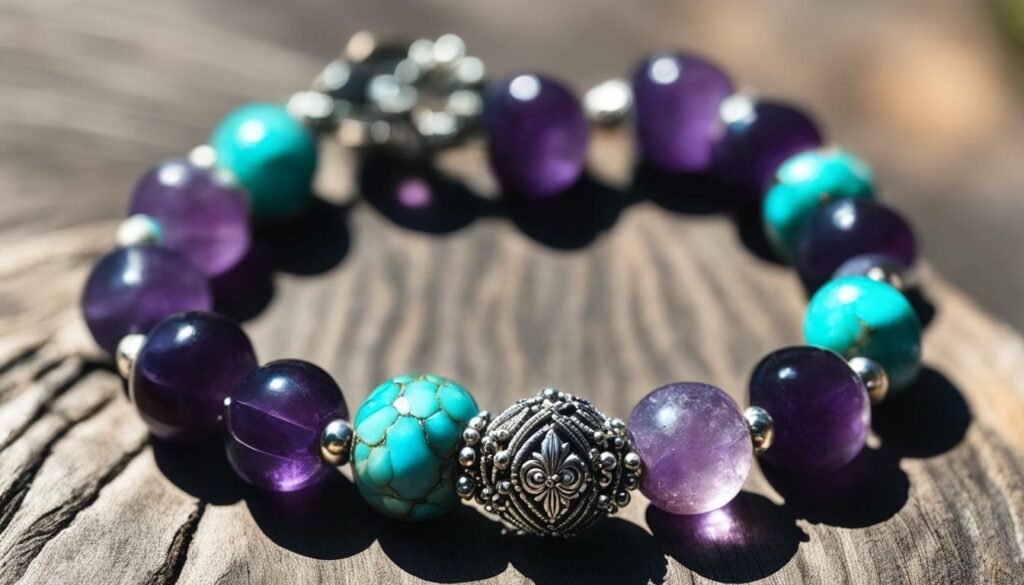
Adding gemstones to your beaded jewelry projects will elevate your designs and give them a professional touch. Experiment with different stone types and colors to create truly unique pieces that shine.
Personalized Accessories: Making Customized Gifts
Looking to add a personal touch to your gifts or accessories? With beginner jewelry making techniques, you can create customized and unique pieces that are sure to impress. Here are a few ideas to get you started:
- Create personalized initial charms for a necklace or bracelet using letter beads.
- Make a beaded bracelet with birthstone beads that correspond to each family member’s birth month.
- Design a friendship bracelet with your friends’ favorite colors.
With just a few supplies and a little creativity, you can make a meaningful and thoughtful gift that your loved ones will cherish. Plus, personalized accessories are a trendy way to show off your style and personality. Get started on your beginner jewelry making journey today!
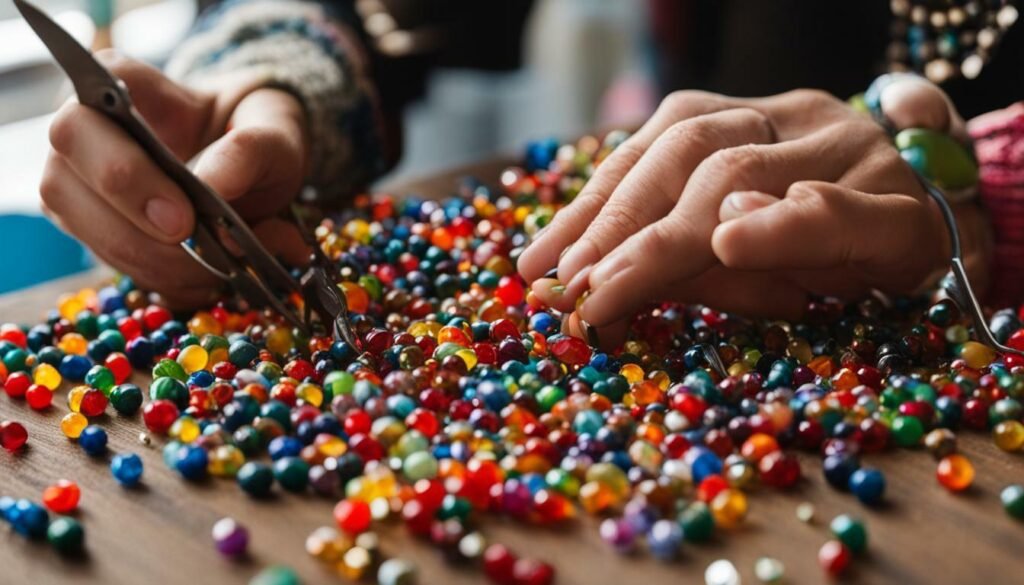
Beading, like any art form, can come with its own set of challenges. Don’t get discouraged when you run into issues – instead, try these tips and tricks to overcome common problems:
- If your thread keeps knotting, try coating it with beeswax or Thread Heaven for smoother beading.
- If your beads seem to be slipping, use a smaller needle or heavier thread to create tighter tension.
- If your beads are uneven, try sorting them by size or weight before starting your project.
- If you’re having trouble with a specific stitch, practice with cheaper beads or thread until you get the hang of it.
Remember, practice makes perfect, and even experienced beaders encounter issues from time to time. With these tips and tricks, you’ll be able to troubleshoot and overcome any challenges that come your way.
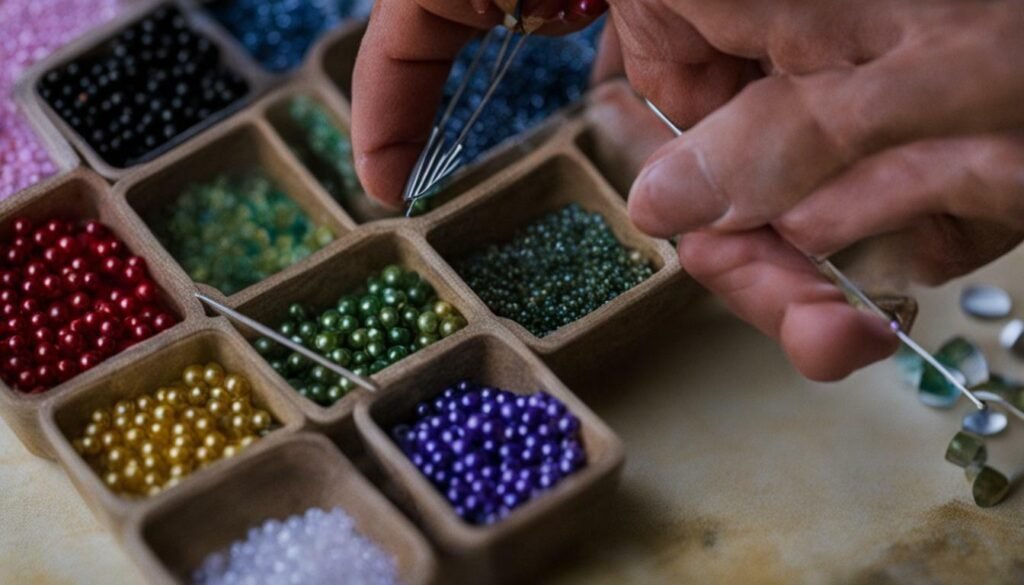
Congratulations, you’ve mastered the basics of beading! Now it’s time to take your skills to the next level with more advanced techniques. Here are some tips to help you challenge yourself:
- Experiment with new stitch patterns like tubular herringbone or chenille stitch
- Create intricate bead embroidery designs by combining various stitches and techniques
- Explore the world of wire wrapping to add texture and dimension to your pieces
- Try out bead crochet or kumihimo braiding for a unique twist
Don’t be afraid to make mistakes – they can often lead to innovative designs and a deeper understanding of the craft. Keep practicing and pushing yourself to try new things, and you’ll soon be creating stunning, one-of-a-kind pieces.
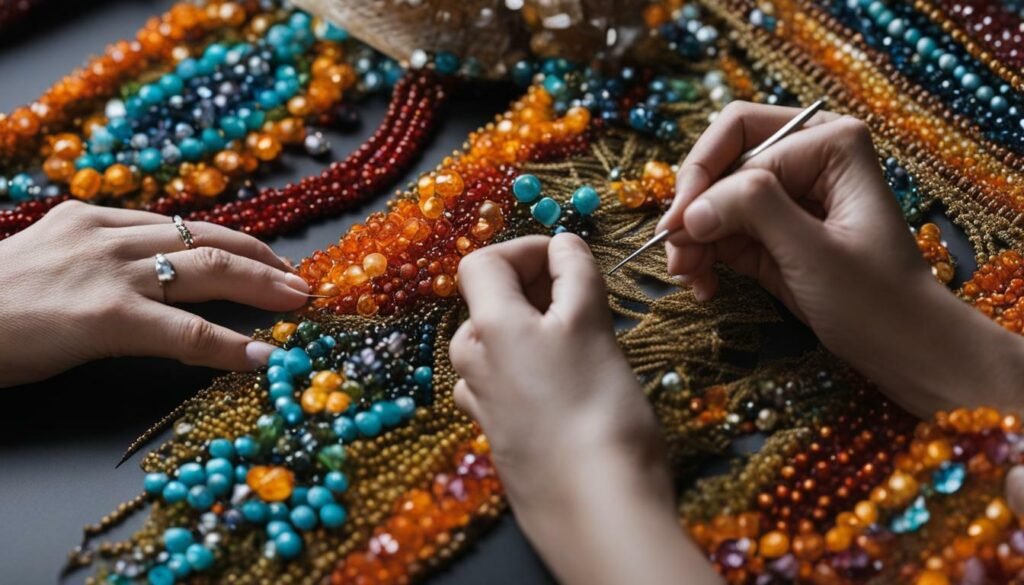
Remember to take frequent breaks during your beading sessions to avoid eye strain and hand fatigue. And most importantly, have fun and enjoy the process of creating beautiful jewelry with your newfound skills.
Building Your Beading Network: Community and Resources
As a beginner beader, building your network and finding the right resources can be essential to advancing your craft. Here are some tips to help you connect with fellow beaders:
- Join online forums to connect with other beaders and get advice.
- Attend workshops and classes to learn new techniques and meet other enthusiasts.
- Visit local bead shops to find supplies and connect with other beaders in person.
Having a supportive community can make all the difference in achieving your beading goals. But what about the tools and supplies you need to create your beautiful pieces?
When it comes to beading supplies, there is a wide variety of options available. Here are some essentials to consider for your beading kit:
| Supply | Description |
|---|---|
| Needles | Choose needles based on the size of the beads and thread you’re using. |
| Thread | Choose thread based on the weight and strength needed for your beading project. |
| Pliers | Use pliers to cut wire, open and close loops, and bend wire into shape. |
| Bead mats | Use bead mats to keep beads from rolling away and to organize your work surface. |
As you progress in your beading journey, you may also want to invest in more advanced tools and supplies, such as bead looms and bead boards. But starting with the basics will help you build a strong foundation for your craft.

Remember, the most important thing is to have fun and let your creativity shine. Keep exploring, learning, and sharing with your beading community, and your skills and confidence will continue to grow.
Caring for Your Beaded Jewelry: Maintenance and Preservation
Now that you’ve created your stunning beaded jewelry pieces, it’s essential to care for them properly. Follow these tips to ensure their longevity:
- Clean your jewelry regularly with a soft cloth, mild soap, and warm water. Avoid harsh chemicals and abrasive materials.
- Store your jewelry in a cool, dry, and airtight container to prevent oxidation and discoloration.
- Avoid exposing your jewelry to extreme heat or cold, as it can damage the beads or warp the wire.
- Remove your jewelry before engaging in activities that could potentially damage the beads or wire, such as swimming, exercising, or cleaning.
- Inspect your jewelry periodically for any loose or broken beads, clasps, or wire. Repair or replace any damaged components to prevent further damage.
With proper care and maintenance, your beaded jewelry pieces will continue to dazzle and delight for years to come.
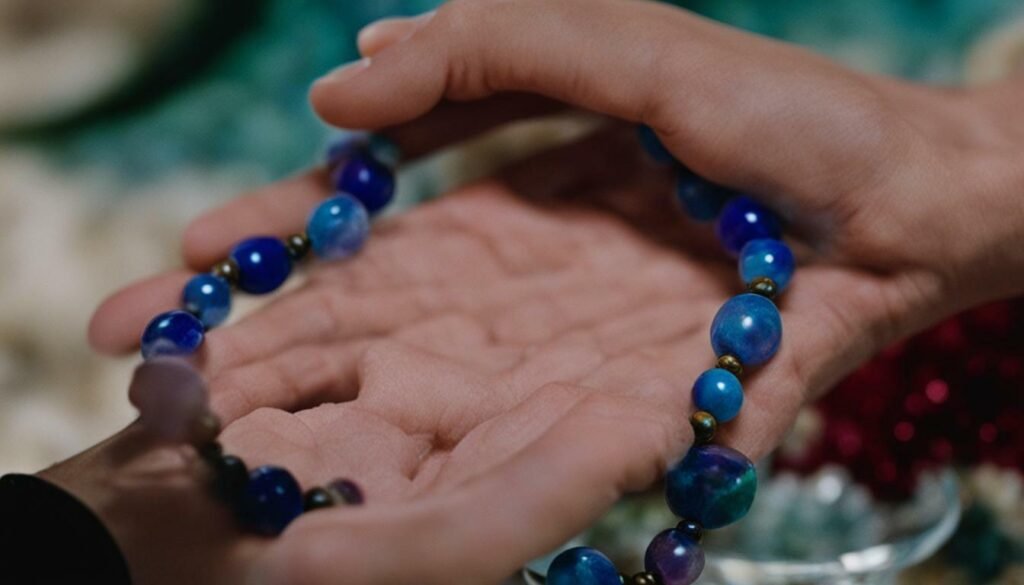
Remember, taking care of your jewelry is essential to prevent damage and extend its lifespan. Keep these simple tips in mind to maintain the beauty of your beaded jewelry.
Exploring New Horizons: Experimenting with Different Materials
Why limit yourself to traditional beads when there’s a whole world of materials to explore? Incorporating different elements into your beaded jewelry designs can add a unique touch and take your creations to the next level. Here are some ideas to experiment with:
- Leather: Use leather cords or strips to create a rustic or bohemian look.
- Crystals: Add sparkle and glamour to your jewelry by incorporating crystals or rhinestones.
- Ceramics: Use ceramic beads or pendants for a more organic and natural feel.
- Metals: Add metal accents, such as charms or beads, for an edgy or industrial look.
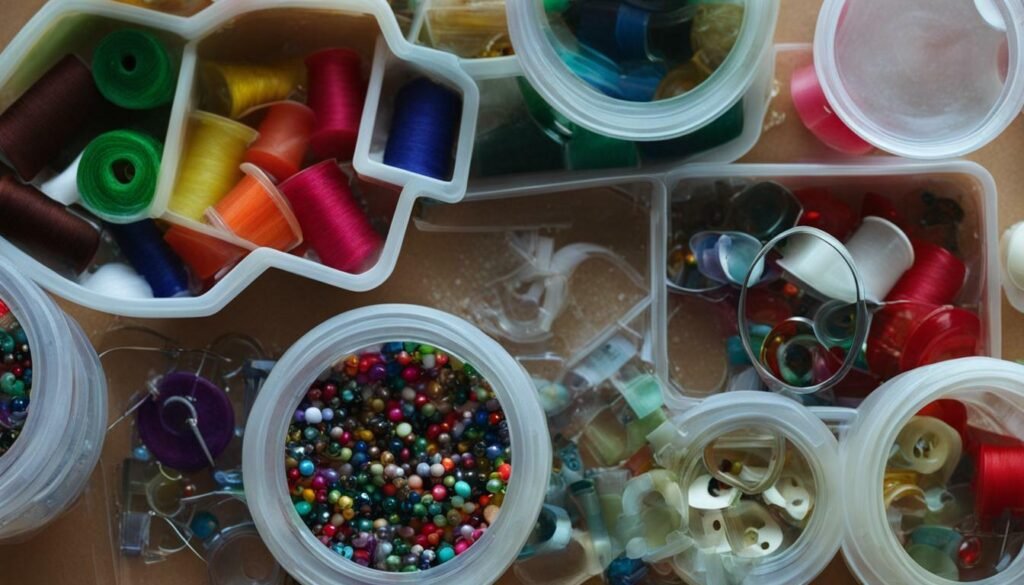
Don’t be afraid to mix and match different materials to create a truly one-of-a-kind piece. Just be sure to choose materials that complement each other and don’t overwhelm the design. The possibilities are endless, so let your imagination run wild!
Conclusion: Unleash Your Creative Potential with Beading Jewelry Basics
Congratulations on completing the journey through the basics of beading jewelry! You now have the knowledge, tools, and inspiration to create your own dazzling pieces. Remember to:
- Choose the right materials for your designs
- Master the foundational techniques such as stringing, knotting, and wirework
- Discover your unique style and color palettes
- Explore advanced techniques and new materials for experimentation
- Care for and preserve your jewelry to ensure its longevity
- Find a vibrant beading community and valuable resources for further growth and learning
Enjoy the fulfilling and rewarding world of beaded jewelry crafting. With your newfound skills and creativity, you can transform beads into wearable works of art that reflect your unique personality. Start exploring the endless possibilities of Beading Jewelry Basics today!
FAQ
What is beading jewelry?
Beading jewelry is the art of creating jewelry using beads, threads, wires, and various techniques. It involves stringing, weaving, or stitching beads together to form beautiful and unique designs.
How do I get started with beading?
To get started with beading, you’ll need some basic supplies like beads, beading thread or wire, needles, and pliers. You can then learn different beading techniques and experiment with designs to create your own jewelry pieces.
What are the essential tools and supplies for beading?
Essential tools and supplies for beading include needles, beading thread or wire, a bead mat, pliers, bead caps, clasps, and jump rings. These tools will help you string beads, secure connections, and add finishing touches to your jewelry.
What are some commonly used beading techniques?
Some commonly used beading techniques include stringing, knotting, weaving, and wirework. These techniques allow you to create different patterns, textures, and structures with beads to bring your jewelry designs to life.
How do I find inspiration for my beaded jewelry designs?
You can find inspiration for your beaded jewelry designs from various sources such as nature, art, fashion, and culture. Experiment with different themes, colors, and patterns to find your unique style and create one-of-a-kind pieces.
How do I choose the right color palette for my beaded jewelry?
When choosing a color palette for your beaded jewelry, consider color theory principles like complementary, analogous, or monochromatic schemes. Play around with different color combinations to create harmonious and visually appealing designs.
Are there any step-by-step tutorials for learning beading stitches?
Yes, there are plenty of step-by-step tutorials available online and in books that can help you learn popular beading stitches like peyote stitch, herringbone stitch, and brick stitch. These tutorials provide clear instructions and visuals to guide you through the process.
How can I incorporate gemstones into my beaded jewelry?
To incorporate gemstones into your beaded jewelry, you can choose gemstone beads, cabochons, or faceted stones and incorporate them into your designs. Learn how to prepare and securely attach gemstones to create stunning and elegant pieces.
Can I make personalized accessories or customized gifts with beading?
Absolutely! Beading allows you to create personalized accessories and customized gifts using basic jewelry-making techniques. From initial charms to beaded bracelets, you can make heartfelt presents for your loved ones.
What should I do if I encounter common issues while beading?
If you encounter common issues like loose threads, tangled beads, or uneven tension while beading, don’t worry! There are helpful tips and tricks to troubleshoot these problems. You can find solutions to common beading issues and continue creating beautiful jewelry.
Are there more advanced beading techniques for experienced crafters?
Yes, once you’ve mastered the basics, you can explore more advanced beading techniques like bead embroidery and bead weaving. These techniques allow you to create intricate and artistic jewelry pieces, challenging yourself and expanding your skills.
Where can I find resources and a community for beading?
You can find valuable resources and connect with a vibrant beading community through online forums, workshops, and local bead shops. These platforms provide opportunities to learn, share ideas, and connect with fellow beading enthusiasts.
How do I care for and preserve my beaded jewelry?
To care for and preserve your beaded jewelry, you should clean it regularly using gentle methods, avoid exposing it to harsh chemicals or excessive moisture, and store it in a safe place like a jewelry box or pouch. These practices will help maintain the beauty and longevity of your creations.
Can I experiment with different materials besides beads in my jewelry?
Absolutely! Beading allows you to experiment with different materials like leather, crystals, ceramics, and more. Incorporating these elements into your beaded jewelry designs can add a unique touch and expand your creative possibilities.
